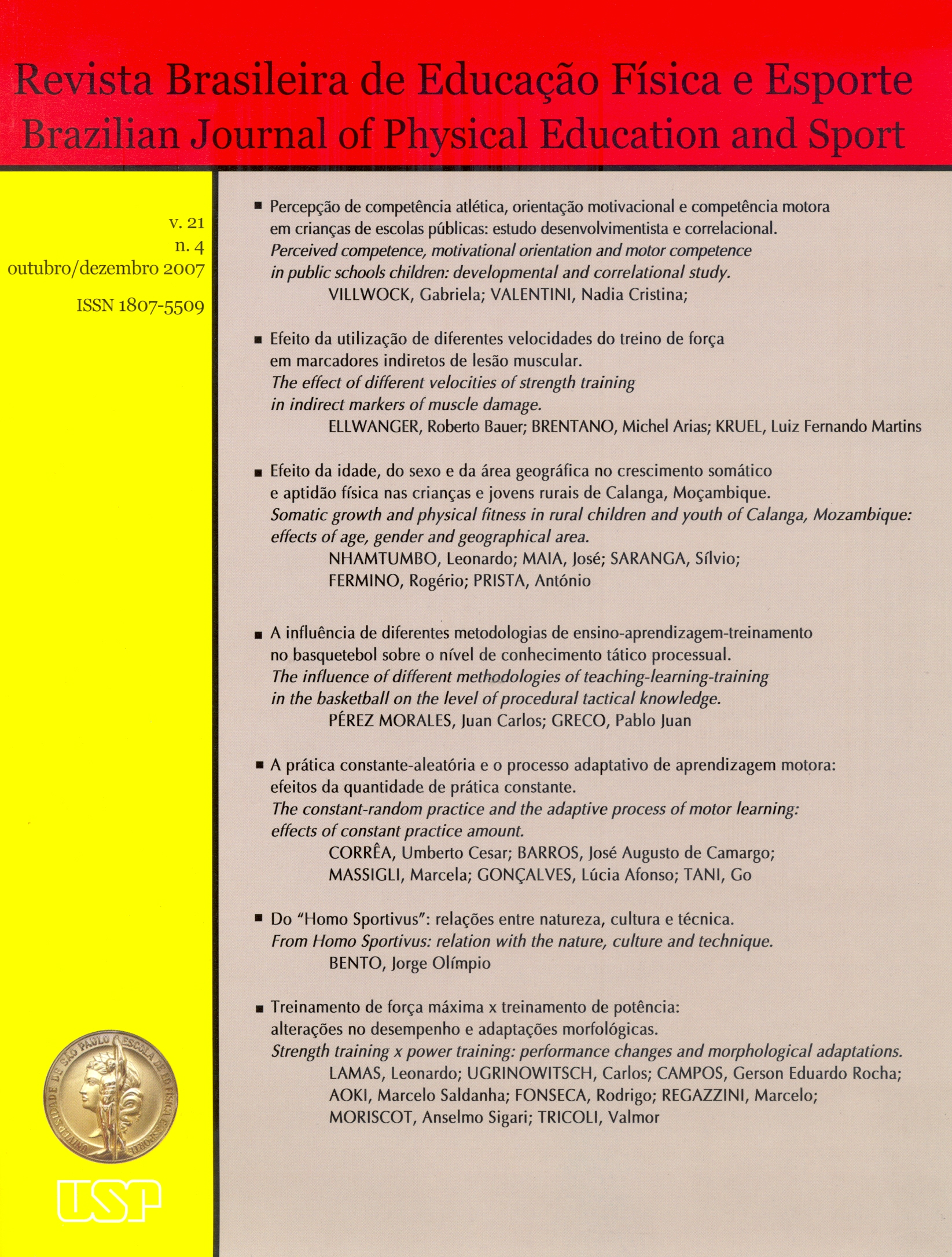Efeito da utilização de diferentes velocidades do treino de força em marcadores indiretos de lesão muscular
DOI:
https://doi.org/10.1590/S1807-55092007000400002Palavras-chave:
Exercício excêntrico, Lesão muscular, Velocidade de contraçãoResumo
Contrações excêntricas requerem o alongamento do músculo esquelético durante a produção de força. É bem estabelecido que exercícios excêntricos promovem altos níveis de lesão muscular. Entretanto, não existe consenso sobre a influência da velocidade de contração na magnitude e recuperação da lesão muscular decorrente desse exercício. O objetivo desse estudo foi verificar a influência da velocidade de contração na magnitude da lesão muscular. Oito homens treinados, sem histórico de lesão neuromuscular, executaram duas sessões de 30 contrações excêntricas isocinéticas máximas, uma com velocidade rápida (180°.s-1) e outra a velocidade lenta (20°.s-1), com os flexores do cotovelo do braço dominante. As duas sessões foram separadas por cinco semanas e a ordem de execução das diferentes velocidades foi randomizada. O torque isométrico (TI), amplitude de movimento (ADM), perímetro do braço (PER) e dor muscular tardia (DMT) foram medidas antes, imediatamente depois (exceto DMT), 24 h, 72 h e 120 h após cada protocolo de exercício excêntrico. As comparações foram feitas através de análise de variância com medidas repetidas, teste "Post-Hoc" de Bonferroni e teste-t dependente (p ≤ 0,05). Ambos os protocolos mostraram uma redução no torque isométrico logo após a sessão (20°.s-1: 82 ± 9,4 N.m x 53,8 ± 12,3 N.m; 180°.s-1: 79 ± 11 N.m x 63,1 ± 11,7 N.m), mas a força foi recuperada rapidamente após a 180°.s-1, enquanto que na 20°.s-1 a força permaneceu diminuída até 72 h pós-exercício (73 ± 6,4 N.m). A ADM foi reduzida imediatamente depois e 24 h pós-exercício apenas em 180°.s-1 (127 ± 12° x 117 ± 7,64°). Por outro lado, o PER aumentou imediatamente depois e permaneceu aumentado até 24 h pós-exercício apenas em 20°.s-1 (34 ± 3,4 cm x 35,2 ± 3,57 cm), sem modificações em 180°.s-1. A DMT se desenvolveu 24 h pós-exercício em ambas as velocidades (20°.s-1: 2,7 ± 1,3 ; 180°.s-1: 2,1 ± 1) e continuou maior que os valores pré-exercício 72 h pós-exercício, nas duas velocidades. Nós concluímos que a velocidade de contração da contração excêntrica afeta diferentemente a recuperação dos marcadores indiretos de lesão muscular; mas não influencia na magnitude deles.Downloads
Os dados de download ainda não estão disponíveis.
Downloads
Publicado
2007-12-01
Edição
Seção
naodefinida
Licença
Todo o conteúdo da revista, exceto onde está identificado, está licenciado sob uma Licença Creative Commons (CC-BY)
Como Citar
Ellwanger, R. B., Brentano, M. A., & Kruel, L. F. M. (2007). Efeito da utilização de diferentes velocidades do treino de força em marcadores indiretos de lesão muscular . Revista Brasileira De Educação Física E Esporte, 21(4), 259-270. https://doi.org/10.1590/S1807-55092007000400002


